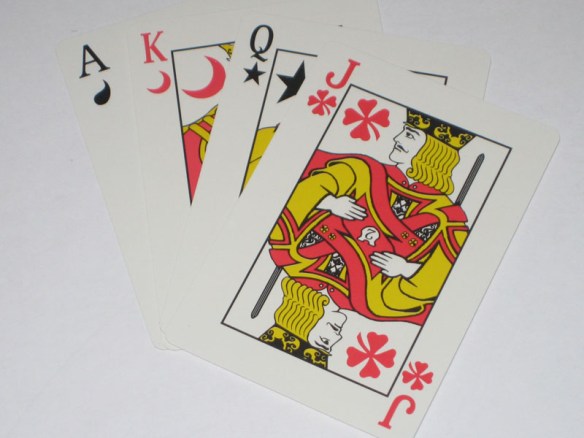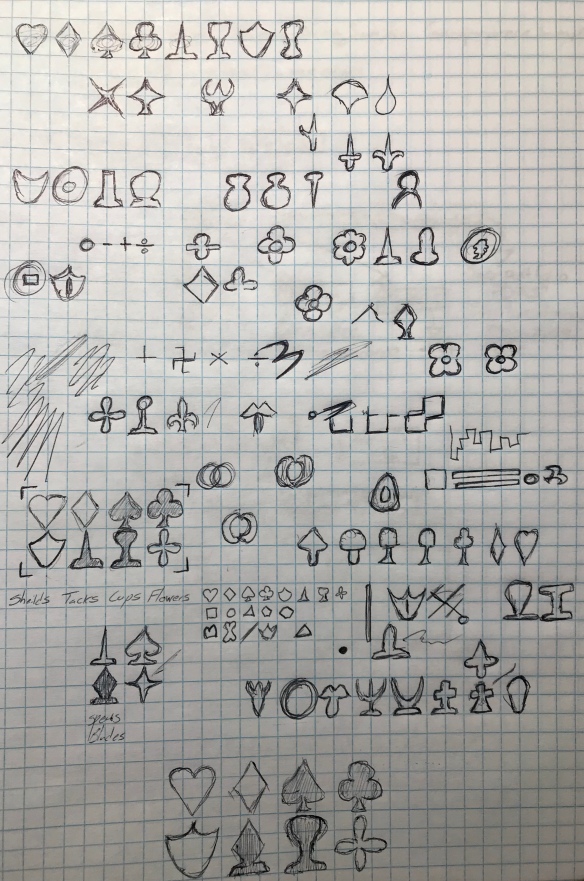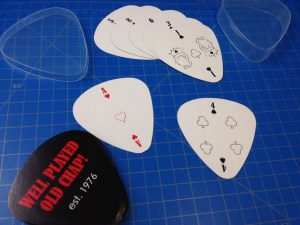I have a large playing card collection; I love decks of cards. I’m not entirely sure why I like them so much, but I do. And I’ve ended up with hundreds upon hundreds of decks of cards via my collecting. It was only a matter of time before I came upon one of the many more unique decks of cards out there.
Most of us know the classic French deck as the one we use all of the time, with four suits that don’t make a whole lot of sense, 13 cards per suit, and two jokers (that are in no way related to the fool from Tarot). This deck is accepted by many in the United States and abroad as the standard deck. And it is so popular that it is easily the standard of the world. But variations are fun, and while the suits and number of cards in each suit change over several European countries (Germany, Austria, Italy, and Spain all have different styles), for some people that isn’t enough.

Some people question why we only have four suits with games like bridge, which can handle more suits (so I’m told, I can’t actually play bridge, but I think we’ve all played a game where suit doesn’t really matter). One of the earliest (and one of the only) decks that I found that realized this was the vintage Sextet Bridge deck that I picked up from a garage sale. The new suits of wheels (ship wheels) and racquets (as in tennis), while interesting, are only that. The design of the pips are far too complicated and modern to really fit the motif of a deck of cards, but are still fun nonetheless.

After seeing these, I became fascinated by decks that added more suits to the standards bunch. The most common of these are the Star-Deck and various other decks that include stars as a fifth suit, like the game Five Crowns. The star works as an addition, but it’s a bit bland, and including it smudges the overall design appearance that is so refined, in my opinion.


While five suited decks were fun, and so were decks with non-traditional suits, I wanted more. How many suits could one fit in a deck and still have it be useful? I started looking at other six-suited decks. The Blue Sea deck, which is available from print on demand services, does this, but again I think the new suits don’t quite fit the older deck. The Empire deck of cards with anchors and crowns makes a really good and nicely fitting deck, but I think better could be done. And that’s when I found a blog post from a graphic designer (New Link) online about this very topic in which he presented his own two new suits designed specifically to blend in with the existing decks (the symbol for every suit can be made with fewer than 7 lines). These two new suits are wonderful and I believe they are the best-designed additions to a normal deck of cards that exist. I just wish there was a deck using them (Edit: It appears there is now a deck featuring these cards).


But I wasn’t satisfied. I wanted more suits, not for any reason, really (some people want to play Cripple Mr. Onion). I just wanted to see if companies could consistently design a counterpart, or set of counterparts, to the modern French deck. The answer to that for me was unfortunately no. While the Fat Pack playing cards, and 8 Suit playing cards are far from terrible (the green Eagle as a fifth suit was terrible*) they do fail at being what I wanted, which is a simple and consistent addition to the French suits. The makers of these decks read more into the patterns of what the shapes represent rather than the patterns of the shapes themselves. Still, I was going to obtain several decks and play with them (in what game? Well I’d have to invent one, or play Cripple Mr. Onion).


I never did end up buying either of those decks, and after getting back into collecting strange decks after buying them some odd ones at Garage Sales and thrift stores (including Five Crowns) I went on the same journey of finding photos of each of the differently suited decks I’ve talked about. I was less satisfied this time than I was originally, and decided that I would make my own. I’m far from the greatest designer in the world, but I stuck with several of the principles that were used in the creation of the six-suited cards, and several of my own, like the simple line numbers. I decided that adding new red and black cards seemed like it would be problematic so I decided the cards would be in two new differently colored pairs (then each one would be individually colored, which was prompted by me looking at 4-colored, 4-suited decks).

Right to Left Top to Bottom: Spades, Hearts, Wheels, Towers, Diamonds, Clovers (Clubs), Globes, and Sheilds
What I came up with was this Hearts, Diamonds, Spades, Clovers, Wheels, Shields, Globes, and Towers. Each is paired off the by similarity in the bottom half, hearts and diamonds being pointy, shields and wheels being round etc. I made these cards into a 104-card deck (with the other alteration of using a P for Prince/Princess instead of a J for Jack) and had them printed at a print-on-demand service. While they aren’t amazing, I think with refinement and a better quality printing they will turn out great.

I’ve created several games to play with them, and if they are a hit with my friends (we generally play more complex games at game-night so maybe this could spice cards up enough to get it back into the front for a while) I will hopefully make more. And I don’t think that I’m finished even with the concept of my new suits. I’m sure they will change, as they need to change, and as playing cards changed when they needed to change over centuries of use.
*































